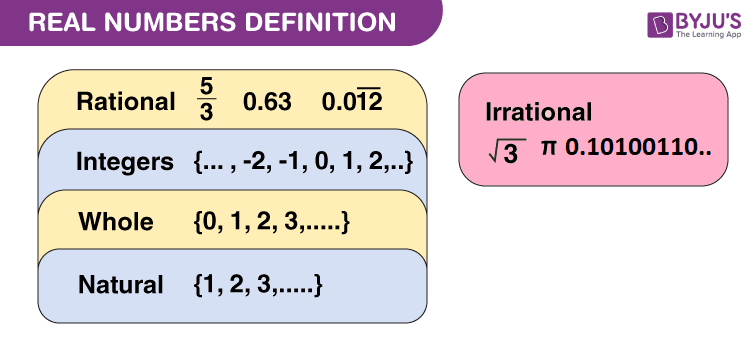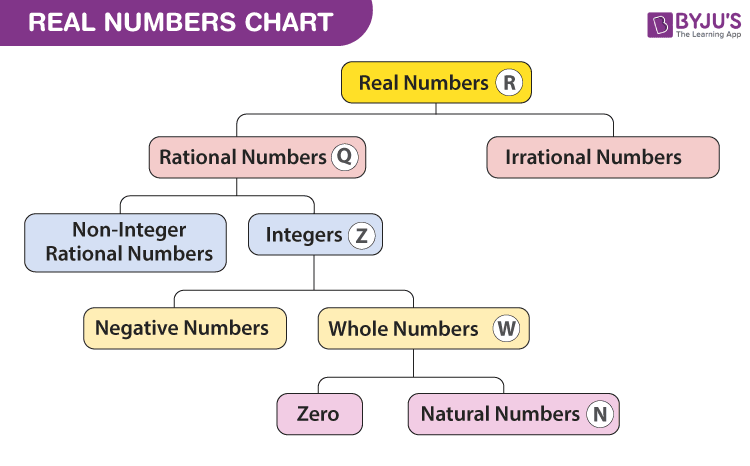what did the king of the real valued functions say to the imaginary numbers
Existent numbers are simply the combination of rational and irrational numbers, in the number organisation. In full general, all the arithmetic operations can exist performed on these numbers and they tin exist represented in the number line, also. At the aforementioned time, the imaginary numbers are the un-real numbers, which cannot be expressed in the number line and is commonly used to represent a complex number. Some of the examples of real numbers are 23, -12, 6.99, five/two, π, and and so on. In this article, nosotros are going to hash out the definition of real numbers, properties of real numbers and the examples of the real number with consummate explanations.
Table of contents:
- Definition
- Prepare of real numbers
- Nautical chart
- Properties of Existent Numbers
- Commutative
- Associative
- Distributive
- Identity
- Questions
- FAQs
Existent Numbers Definition
Existent numbers can be defined as the union of both rational and irrational numbers. They tin can be both positive or negative and are denoted by the symbol "R". All the natural numbers, decimals and fractions come up under this category. See the figure, given below, which shows the nomenclature of real numerals.

Read More:
- Natural Numbers And Whole Numbers
- Rational And Irrational Numbers
- Integers
- Existent Numbers For Grade 10
- Important Questions Course 10 Maths Chapter 1 Real Numbers
Gear up of Existent Numbers
The set of real numbers consists of different categories, such as natural and whole numbers, integers, rational and irrational numbers. In the table given below, all the real numbers formulas (i.due east.) the representation of the classification of real numbers are defined with examples.
| Category | Definition | Instance |
|---|---|---|
| Natural Numbers | Incorporate all counting numbers which beginning from 1. N = {1, two, 3, 4,……} | All numbers such every bit 1, 2, three, 4, 5, 6,…..… |
| Whole Numbers | Collection of zero and natural number. W = {0, one, two, 3,…..} | All numbers including 0 such as 0, i, 2, 3, 4, 5, 6,…..… |
| Integers | The collective event of whole numbers and negative of all natural numbers. | Includes: -infinity (-∞),……..-four, -3, -2, -ane, 0, 1, 2, 3, iv, ……+infinity (+∞) |
| Rational Numbers | Numbers that can be written in the form of p/q, where q≠0. | Examples of rational numbers are ½, 5/4 and 12/6 etc. |
| Irrational Numbers | The numbers which are not rational and cannot be written in the form of p/q. | Irrational numbers are non-terminating and not-repeating in nature like √2 |
Real Numbers Chart
The chart for the set of real numerals including all the types are given below:

Backdrop of Real Numbers
The following are the four main properties of real numbers:
- Commutative holding
- Associative holding
- Distributive belongings
- Identity holding
Consider "one thousand, n and r" are iii real numbers. Then the higher up properties can exist described using m, n, and r as shown below:
Commutative Belongings
If m and n are the numbers, and then the general form will be g + n = n + g for addition and m.north = n.m for multiplication.
- Add-on: yard + due north = n + one thousand. For instance, 5 + 3 = 3 + 5, 2 + four = 4 + 2.
- Multiplication: g × n = n × k. For instance, 5 × iii = 3 × 5, 2 × 4 = 4 × two.
Associative Holding
If thou, northward and r are the numbers. The general form volition be m + (n + r) = (m + n) + r for addition(mn) r = g (nr) for multiplication.
- Addition: The general course volition exist one thousand + (n + r) = (m + n) + r. An example of additive associative property is 10 + (3 + 2) = (x + three) + 2.
- Multiplication: (mn) r = one thousand (nr). An example of a multiplicative associative property is (2 × 3) 4 = 2 (3 × iv).
Distributive Property
For 3 numbers 1000, n, and r, which are real in nature, the distributive property is represented every bit:
m (n + r) = mn + mr and (m + n) r = mr + nr.
- Example of distributive belongings is: 5(2 + iii) = 5 × 2 + 5 × 3. Here, both sides will yield 25.
Identity Property
There are additive and multiplicative identities.
- For addition: one thousand + 0 = one thousand. (0 is the additive identity)
- For multiplication: m × 1 = ane × grand = thou. (one is the multiplicative identity)
Practice Questions
- Which is the smallest composite number?
- Testify that any positive odd integer is of the form 6x + i, 6x + iii, or 6x + 5.
- Evaluate ii + 3 × 6 – 5.
- What is the production of a not-nothing rational number and an irrational number?
- Can every positive integer be represented as 4x + 2 (where x is an integer)?
Real Numbers Class 9 and ten
In real numbers Class 9, the common concepts introduced include representing existent numbers on a number line, operations on real numbers, backdrop of real numbers, and the police of exponents for existent numbers. In Grade 10, some advanced concepts related to real numbers are included. Apart from what are real numbers, students will likewise learn about the real numbers formulas and concepts such every bit Euclid's Division Lemma, Euclid'due south Partition Algorithm and the fundamental theorem of arithmetic in course 10.
Frequently Asked Questions
What are Natural and Existent Numbers?
Natural numbers are all the positive integers starting from 1 to infinity. All the natural numbers are integers simply not all the integers are natural numbers. These are the gear up of all counting numbers such as 1, 2, 3, four, 5, 6, seven, 8, ix, …….∞.
Real numbers are numbers that include both rational and irrational numbers. Rational numbers such as integers (-2, 0, 1), fractions(1/2, ii.5) and irrational numbers such as √three, π(22/vii), etc., are all existent numbers.
Is Zip a Real or an Imaginary Number?
Zero is considered as both a real and an imaginary number. Equally nosotros know, imaginary numbers are the foursquare root of non-positive existent numbers. And since 0 is as well a non-positive number, therefore it fulfils the criteria of the imaginary number. Whereas 0 is also a rational number, which is defined in a number line and hence a existent number.
Are at that place Real Numbers that are not Rational or Irrational?
No, there are no real numbers that are neither rational nor irrational. The definition of real numbers itself states that it is a combination of both rational and irrational numbers.
Is the real number a subset of a complex number?
Yep, because a circuitous number is the combination of a real and imaginary number. So, if the circuitous number is a fix and so the existent and imaginary numbers are the subsets of it.
What are the backdrop of real numbers?
The properties of real numbers are:
Commutative Property
Associative Property
Distributive Property
Identity Property
Keep visiting BYJU'S to get more such Maths lessons in a simple, concise and easy to empathise mode. Also, register at BYJU'S – The Learning App to get consummate assistance for Maths preparation with video lessons, notes, tips and other study materials.
Source: https://byjus.com/maths/real-numbers/
Post a Comment for "what did the king of the real valued functions say to the imaginary numbers"